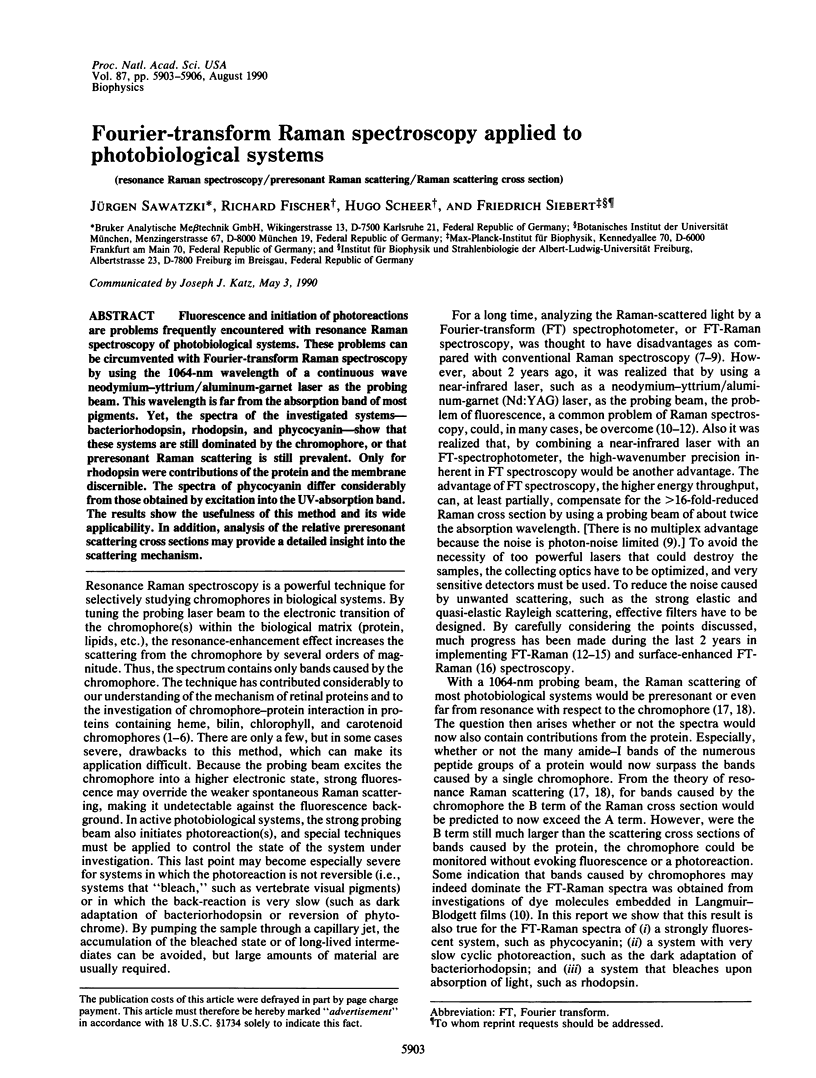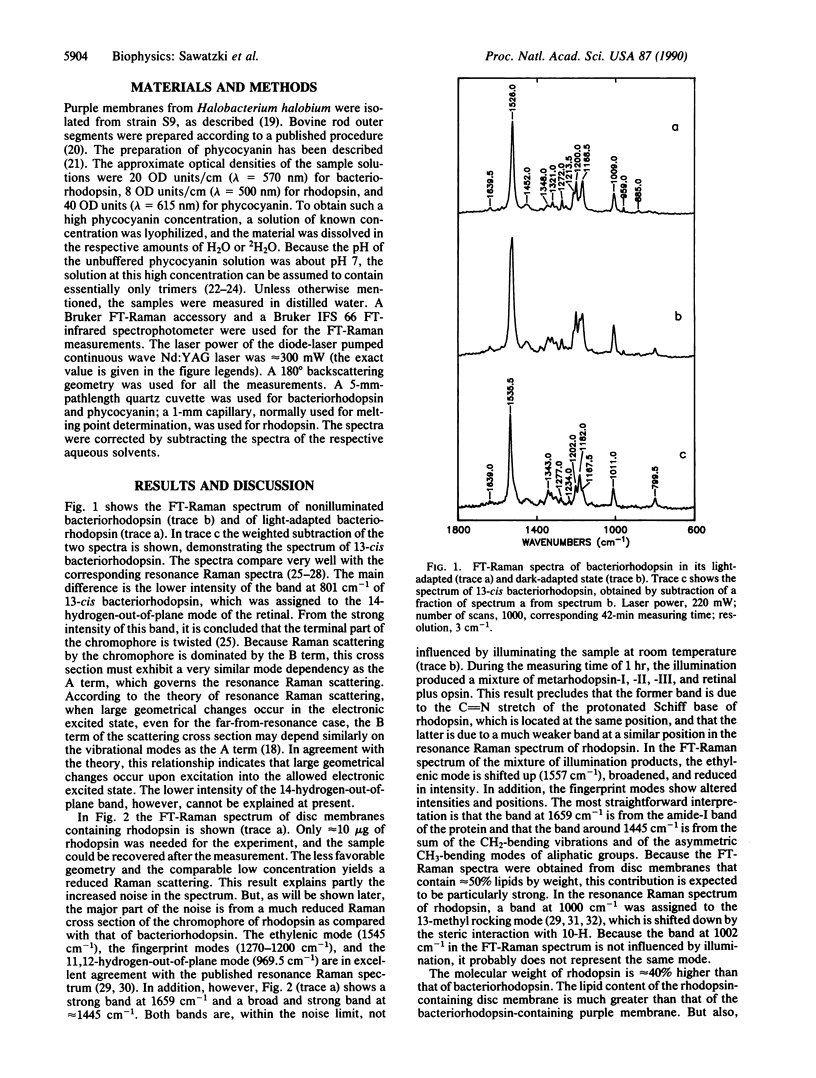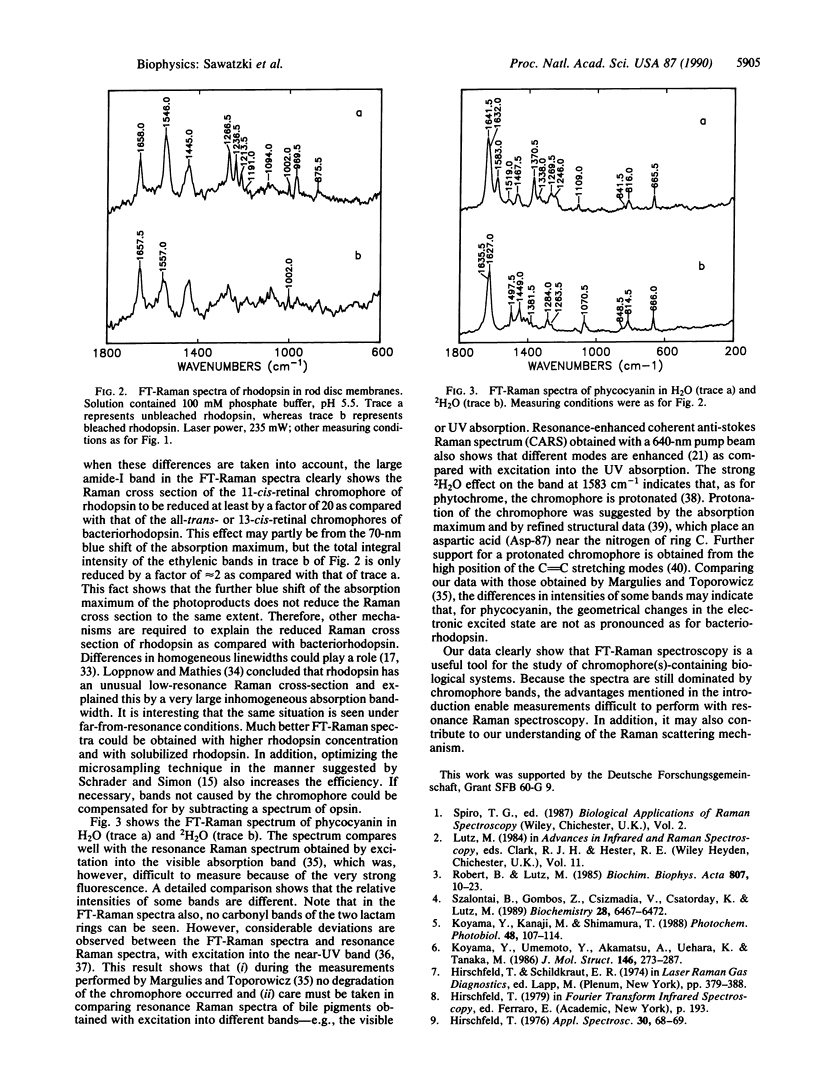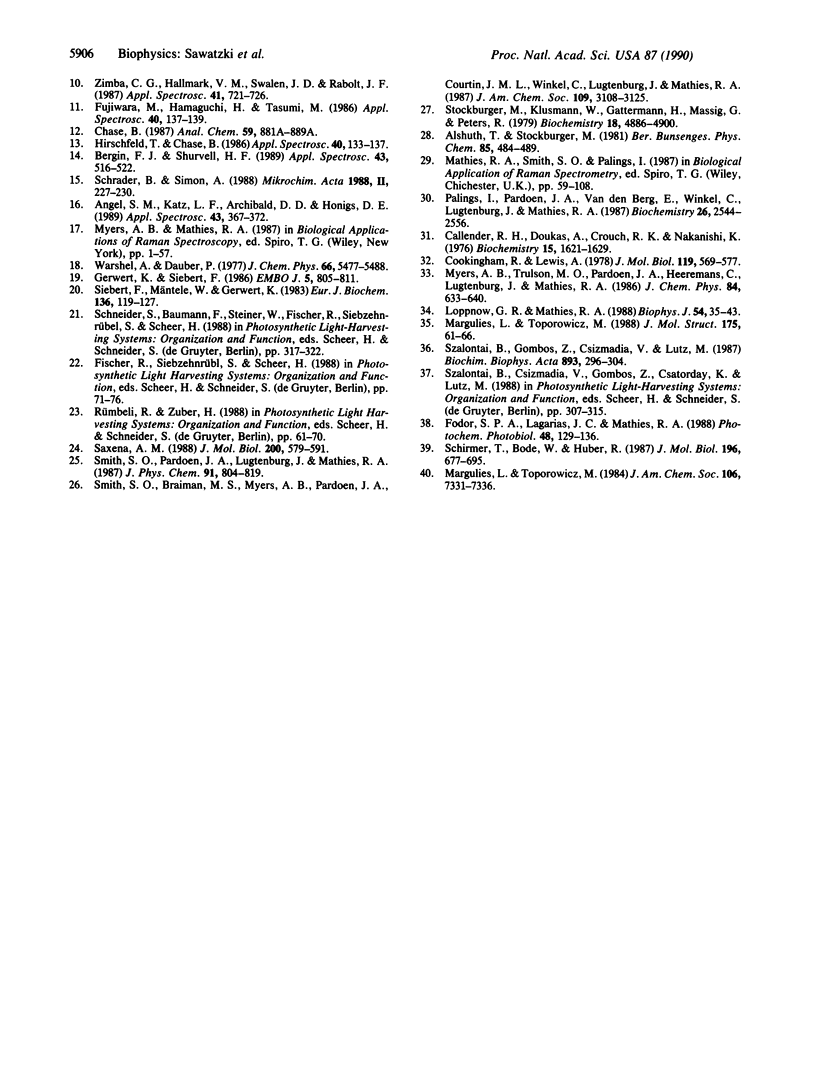Abstract
Fluorescence and initiation of photoreactions are problems frequently encountered with resonance Raman spectroscopy of photobiological systems. These problems can be circumvented with Fourier-transform Raman spectroscopy by using the 1064-nm wavelength of a continuous wave neodymium-yttrium/aluminum-garnet laser as the probing beam. This wavelength is far from the absorption band of most pigments. Yet, the spectra of the investigated systems--bacteriorhodopsin, rhodopsin, and phycocyanin--show that these systems are still dominated by the chromophore, or that preresonant Raman scattering is still prevalent. Only for rhodopsin were contributions of the protein and the membrane discernible. The spectra of phycocyanin differ considerably from those obtained by excitation into the UV-absorption band. The results show the usefulness of this method and its wide applicability. In addition, analysis of the relative preresonant scattering cross sections may provide a detailed insight into the scattering mechanism.
Full text
PDF



Selected References
These references are in PubMed. This may not be the complete list of references from this article.
- Angel I., Taranger M. A. Coupling between hypothalamic alpha 2-adrenoceptors and [3H]mazindol binding site in response to several hyperglycaemic stimuli in mice. Brain Res. 1989 Jun 26;490(2):367–372. doi: 10.1016/0006-8993(89)90256-4. [DOI] [PubMed] [Google Scholar]
- Callender R. H., Doukas A., Crouch R., Nakanishi K. Molecular flow resonance Raman effect from retinal and rhodopsin. Biochemistry. 1976 Apr 20;15(8):1621–1629. doi: 10.1021/bi00653a005. [DOI] [PubMed] [Google Scholar]
- Cookingham R., Lewis A. Resonance Raman spectroscopy of chemically modified retinals: assigning the carbon--methyl vibrations in the resonance Raman spectrum of rhodopsin. J Mol Biol. 1978 Mar 15;119(4):569–577. doi: 10.1016/0022-2836(78)90203-6. [DOI] [PubMed] [Google Scholar]
- Ekholm S., Simon J. H. Magnetic resonance imaging and the acquired immunodeficiency syndrome dementia complex. Acta Radiol. 1988 Mar-Apr;29(2):227–230. [PubMed] [Google Scholar]
- Fodor S. P., Lagarias J. C., Mathies R. A. Resonance Raman spectra of the Pr-form of phytochrome. Photochem Photobiol. 1988 Aug;48(2):129–136. doi: 10.1111/j.1751-1097.1988.tb02797.x. [DOI] [PubMed] [Google Scholar]
- Gerwert K., Siebert F. Evidence for light-induced 13-cis, 14-s-cis isomerization in bacteriorhodopsin obtained by FTIR difference spectroscopy using isotopically labelled retinals. EMBO J. 1986 Apr;5(4):805–811. doi: 10.1002/j.1460-2075.1986.tb04285.x. [DOI] [PMC free article] [PubMed] [Google Scholar]
- Loppnow G. R., Mathies R. A. Excited-state structure and isomerization dynamics of the retinal chromophore in rhodopsin from resonance Raman intensities. Biophys J. 1988 Jul;54(1):35–43. doi: 10.1016/S0006-3495(88)82928-X. [DOI] [PMC free article] [PubMed] [Google Scholar]
- Palings I., Pardoen J. A., van den Berg E., Winkel C., Lugtenburg J., Mathies R. A. Assignment of fingerprint vibrations in the resonance Raman spectra of rhodopsin, isorhodopsin, and bathorhodopsin: implications for chromophore structure and environment. Biochemistry. 1987 May 5;26(9):2544–2556. doi: 10.1021/bi00383a021. [DOI] [PubMed] [Google Scholar]
- Saxena A. M. Phycocyanin aggregation. A small angle neutron scattering and size exclusion chromatographic study. J Mol Biol. 1988 Apr 5;200(3):579–591. doi: 10.1016/0022-2836(88)90544-x. [DOI] [PubMed] [Google Scholar]
- Schirmer T., Bode W., Huber R. Refined three-dimensional structures of two cyanobacterial C-phycocyanins at 2.1 and 2.5 A resolution. A common principle of phycobilin-protein interaction. J Mol Biol. 1987 Aug 5;196(3):677–695. doi: 10.1016/0022-2836(87)90040-4. [DOI] [PubMed] [Google Scholar]
- Siebert F., Mäntele W., Gerwert K. Fourier-transform infrared spectroscopy applied to rhodopsin. The problem of the protonation state of the retinylidene Schiff base re-investigated. Eur J Biochem. 1983 Oct 17;136(1):119–127. doi: 10.1111/j.1432-1033.1983.tb07714.x. [DOI] [PubMed] [Google Scholar]
- Stockburger M., Klusmann W., Gattermann H., Massig G., Peters R. Photochemical cycle of bacteriorhodopsin studied by resonance Raman spectroscopy. Biochemistry. 1979 Oct 30;18(22):4886–4900. doi: 10.1021/bi00589a017. [DOI] [PubMed] [Google Scholar]


